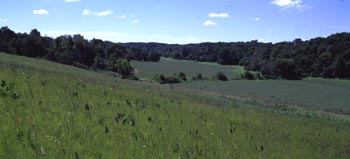
 |
| Jim Edgar, Panther Creek State Fish & Wildlife Area |
"So when the morning’s work was done, Laura took Mary walking over the prairie. Spring flowers were blossoming and cloud-shadows were trailing over the grassy slopes."
- from Laura Ingalls Wilder’s Little Town on the Prairie
If you drive along the highways in Illinois, you may see signs that indicate prairie restoration activities along the roadsides. During summer and fall, you may be lucky enough to see yellow and orange flowers, and swaying grasses. Any prairie you see has components of a healthy prairie ecosystem.
Prairies are unique ecosystems dominated by grasses and other non-woody plants called forbs. These ecosystems are the result of the interactions between the precipitation and temperature of a region, the landforms, how quickly water drains from soil, fire, plants, and animals. Each plays a crucial role in the establishment of a prairie.
A prairie ecosystem includes all the living components-- plants and animals--and all the non-living components-- sun, water, fire, soil, and--nutrients.
|
|
Copyright © 2000 Illinois State Museum